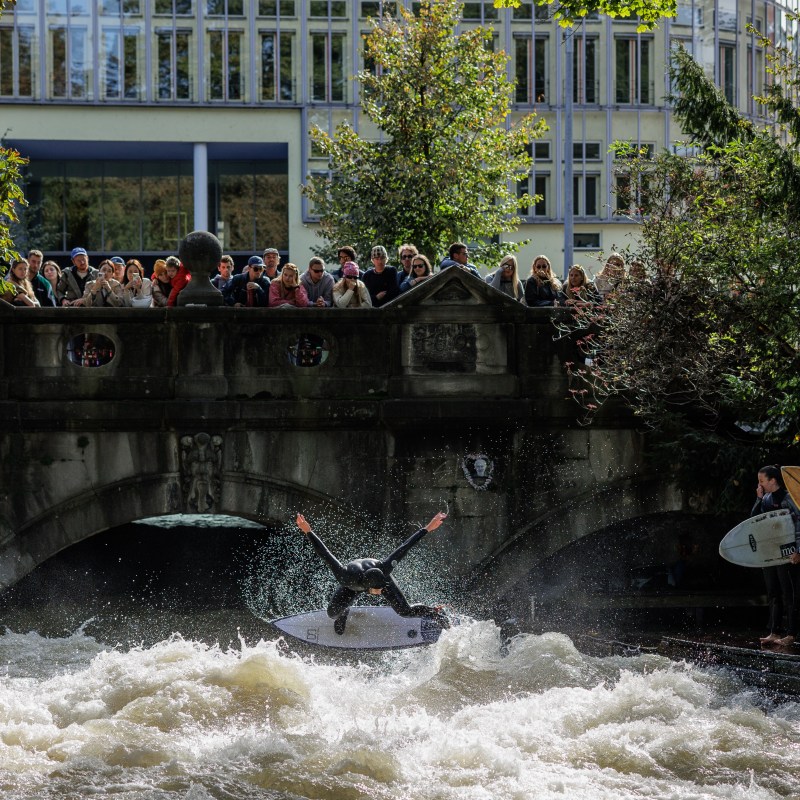
If you’ve spent a lot of time in Germany, you might have heard of Munich’s famous Eisbach Wave. It’s one of the Bavarian capital’s most famous tourist sites and is a beloved staple for sporty locals.
Videos by TravelAwaits
Like the title suggests, the Eisbach Wave is exactly that: a large 3.5-foot wave that forms from the rushing water hitting a concrete step on the riverbed. Locals like to surf it. Visitors like to watch and, at times, get in on the action themselves.
That’s right—you might fly all the way to Munich just to be lured away from the lovely spas, medieval buildings, and cozy beer gardens to watch a surf session.
Or, at least, you might have in the past. Due to a recent incident at the Eisbach Wave, the site has been shut down until further notice.
Here’s what you need to know about the Eisbach Wave, along with why it’s been shut down.
What is the Eisbach Wave, aka the Eisbachwelle?
The Eisbach River is a manmade river that cuts through Munich’s popular Englischer Garten, aka the English Garden. As outlined above, the narrow river hits a large step on the riverbed, which generates a never-ending, 3.5-foot wave that you can surf until the sun sets.
Though Germany isn’t a surfy nation by any stretch, locals have been cruising the Eisbach Wave since the 1970s. Over the decades, the riverbank transformed as curious onlookers set up picnic blankets and cracked open beers.
It became an iconic hangout, to say the least. In 2010, the City of Munich legalized surfing the Eisbach.
What was once an underground urban surf spot became a hit for travelers who wanted to catch a glimpse of Munich’s coolest athletes.
Unfortunately, a fatal incident in April 2025 led firefighters to shut down the Eisbach—without any opening date in sight.
Is the Eisbach Wave actually dangerous?
I like to think anyone who takes one look at the rushing, foamy waters of the Eisbach Wave knows on an instinctual level that it’s not for beginners.
This is an unending wave that’s fed by fast-moving, shallow water and an invisible drop-off, meaning you might want to know a little bit about rapids in addition to surfing if you want to take it on.
In short: yes, surfing the Eisbach is dangerous. Travelers aren’t encouraged to try it out (you’d also need a wetsuit and a surfboard). Even beginner surfers with some experience probably won’t fare well. It’s a tough spot to stand up on the board, nonetheless have a satisfying surfing session.
Sadly, on April 17, 2025, a surfer’s leash (the rubber cord that attaches the surfer’s ankle to their board) got caught on the riverbed. After a grueling 30-minute rescue mission, the surfer was revived on the riverside before being taken to the hospital. She died of her injuries six days later.
Surfing the Eisbach has been forbidden since, and local authorities haven’t announced plans to reopen the site.
Will the Eisbach Wave reopen—and should travelers visit?
Surfing the Eisbach Wave is banned for now, but it looks like authorities are looking into the cause of the fatal incident with security in mind. The Eisbach has been a symbol of Munich’s identity for over a decade, meaning it’s not likely to remain shut down forever.
However, local firefighters are now investigating how security measures can be improved at Eisbach. The riverbed is lined with bricks to prevent erosion, which pose major threats to surfers.
Being that the City of Munich legalized surfing there in 2010, authorities might be liable to improve safety measures or nix surfing the Eisbach altogether.
